River Animals And River People: For A Shared Future
First published in Sanctuary Asia,
Vol. 41
No. 12,
December 2021
Nachiket Kelkar is an ecologist working towards identifying ways to both conserve endangered riverine biodiversity and secure livelihoods of fisherfolk. He believes in interdisciplinary science and conservation approaches that may enable both entities to coexist, even as they remain affected by several anthropogenic threats to river-floodplain ecosystems. He heads the Wildlife Conservation Trust’s (WCT) Riverine Ecosystems and Livelihoods (REAL) programme, which currently focuses on bridging the gap between capture fisheries management and wildlife conservation in the Gangetic plains.
Rizwan Mithawala sat down with him, to understand the complex relationships between river animals and river people, and his vision of their shared future.
You wrote in an article that there is “a deep visceral connection between river animals and river people, one that connects their tissues to river sediment, through fish”. Can you reflect and elaborate on that?
The river, people, and animals are connected through food webs in the riverine ecosystem – in a circle of life and death. The fish in the river are food for so many animals: dolphins, crocodiles, turtles, otters, birds, and other species. People eat the fish and some of these animals; and animals in turn scavenge on the remains of dead people. You watch fishers fishing near cremation ghats along rivers. What are the fish feeding on? The corpses floating on the river? One also sees dolphin calves, gharial hatchlings, and baby fish. Spending time by the river and watching its erosional and depositional processes, changing channel courses, and collapsing sand bars, makes one gradually realise that the river is also constantly digesting and metabolising life, like a silent, gigantic, and slow but effective predator. The river is where you see “Dust Thou Art, To Dust Returnest” in the flesh. You see transformations of matter and energy happen right before you.
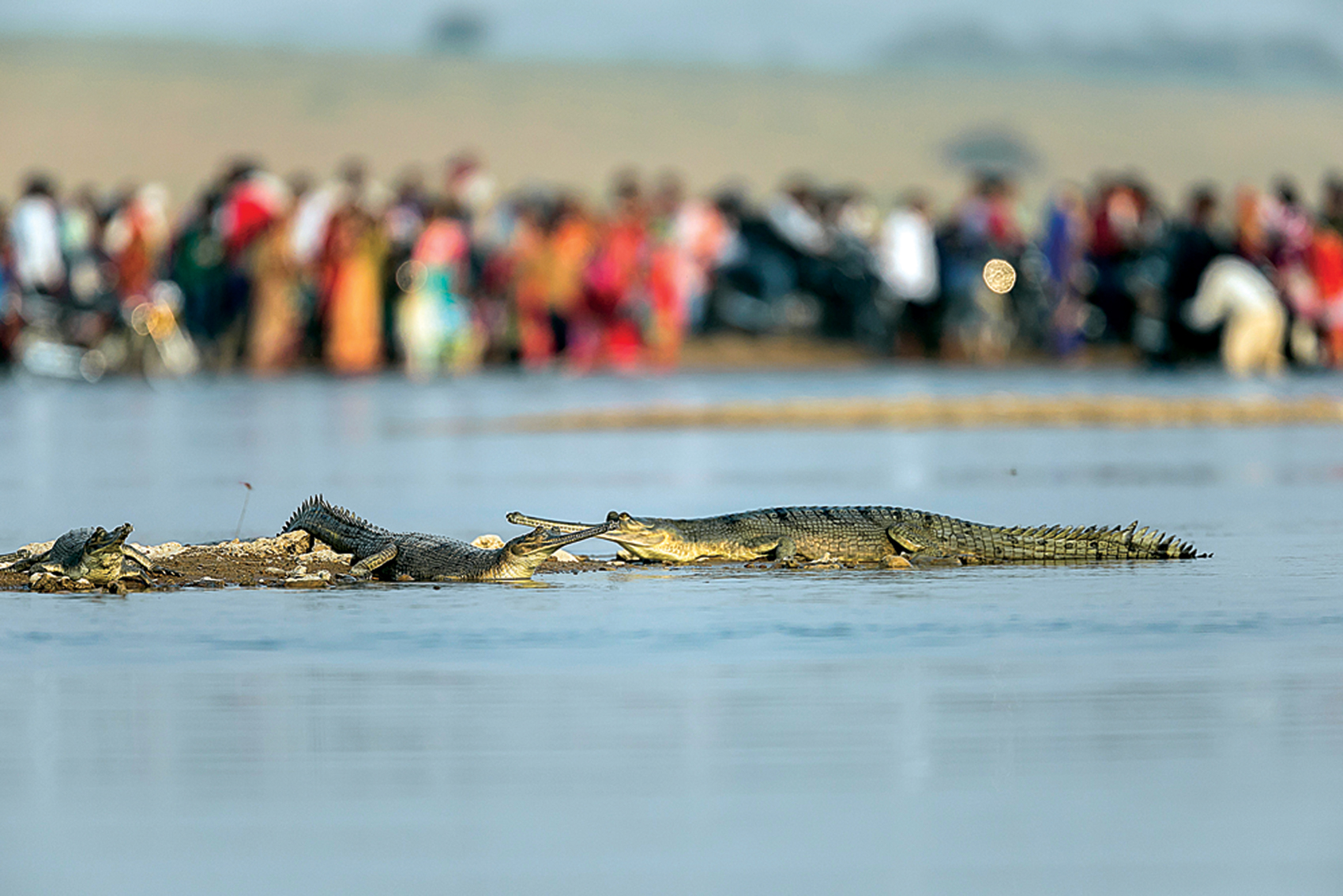
Critically Endangered gharial crocodiles require rivers with adequate flow, clean water, and low human disturbance. The survival of wild gharial populations is strongly dependent on reducing fishing-induced mortality. Photo: Neelabh Dalmia.
My on-ground understanding of conservation challenges has come mainly from forests, where high-intensity anthropogenic pressures generally have a negative impact on the ecosystem. Even if people don’t directly harm the ecosystem and only collect minor forest produce like mahua flowers or tendu leaves, their actions can sometimes lead to human-wildlife conflict. Is the relationship between riverine fishers and the ecosystem any different?
We have to be careful in the way we define “negative impact”. Fishing is an extractive act, similar to hunting or harvesting fruits. So there is bound to be some impact on species sharing space with fishing activity, such as unintentional mortality in fishing nets, or direct hunting of a species by fishers. The extent of impact varies with each type of interaction. However, what appears to be disturbance may actually not always be so, because fishing people and river animals have lived together for thousands of years. Of course, there are differences based on the species involved. Gharials, for instance, are much more sensitive to any human activity than otters or dolphins. Further, I think that a tad overstatement is made out of “overharvesting” or “competition” between fishers and river animals. Fishing technologies used in river ecosystems in India have in fact not changed enough to lead to a collapse of fish stocks, although net materials have changed. We know that fish stocks have declined in our rivers, but the major drivers are environmental and other destructive, human-induced causes (dams, pollution, etc.) rather than fishing. Capture fisheries is also a non-consumptive act when it comes to water use (unlike irrigated agriculture). All this is not to say that fishing is benign. But its overall impact, in my experience, is less than what conservationists usually believe it to be. Our rivers are so altered now that it is difficult to think of an “ideal” state for fishers as well as wildlife; and yet, we see many important populations of endangered riverine species in areas with significant fishing. However, in areas where small populations of these species remain, it is also important to curb fishing to the extent possible – especially the fishing practices that are likely to kill the few individuals of that species remaining there.
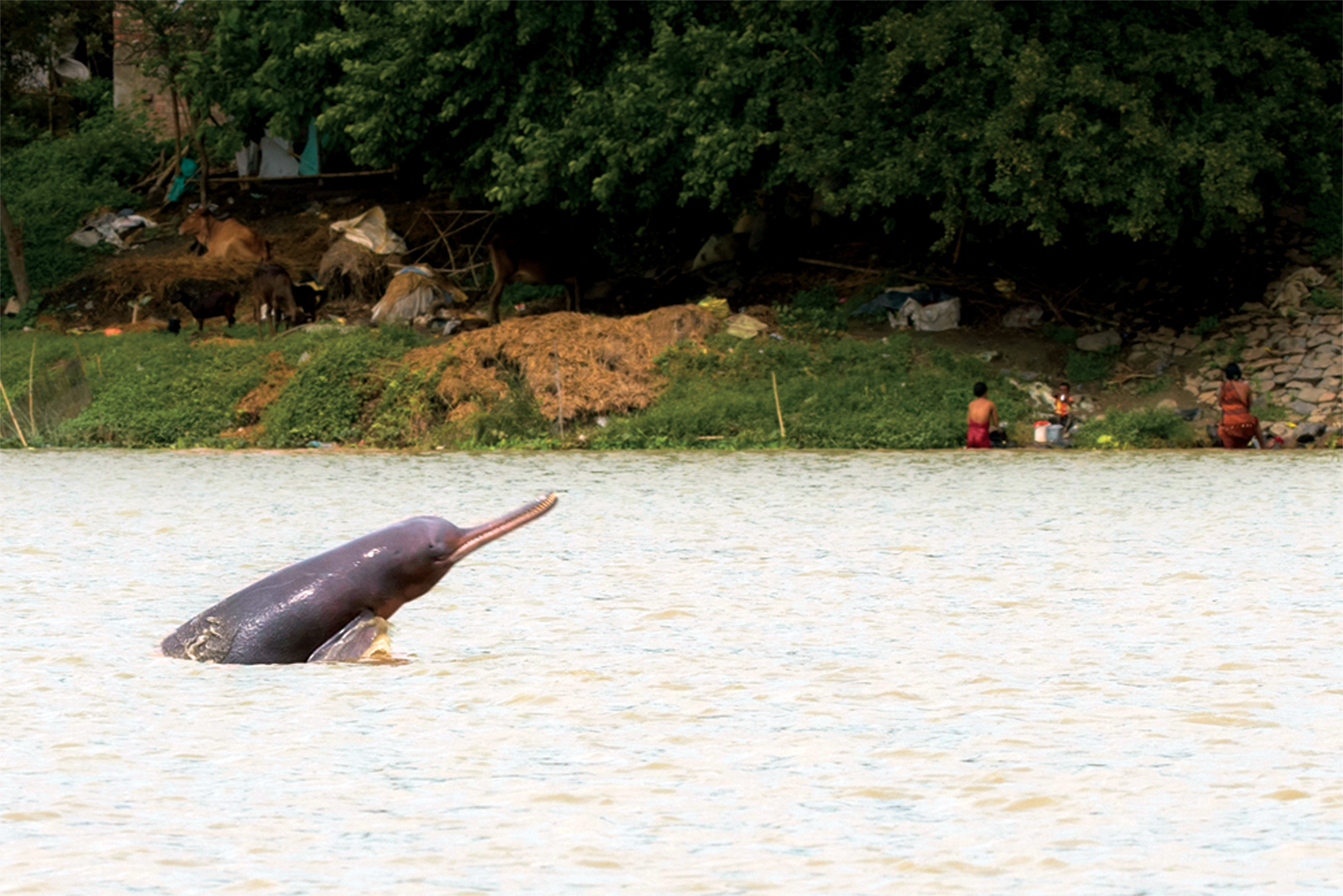
A Ganges river dolphin surfaces, showing its entire snout and flipper bases. Such photographs are rare, as this species does very quick surfacings, often exposing only the blowhole to breathe. Photo: Partha Pratim Kundu.
The Gangetic river dolphin and the gharial are endangered species, like the tiger. Yet they do not enjoy the same level of protection. Why? What ails freshwater species in general, and why do they get less conservation attention?
There are many reasons. For a long time, these species were not well known or even considered unique or charismatic. The Ganges river dolphin, for instance, was known to most people as a large fish or aquatic animal that was sometimes seen in the river, until quite recently. With crocodilians, such as the gharial, there was limited attention until the Government of India’s Project Crocodile was initiated around the same time as Project Tiger, in the early 1970s. Gharials were already extirpated from most regions by hunting during colonial rule in India and by fishers, or drowning by entanglement in nets. The few rivers in which they persisted, like the Chambal and the Gandak, were considered dangerous on account of dacoits. They lay in inaccessible terrain, or in extremely poor regions of northern India, which perhaps afforded the gharials some protection. In general, most people were quite unsure or indifferent as to why crocodiles, generally considered dangerous and unwelcome, needed protection at all. Additionally, tourism for both shikar and photography had taken off in forests of independent India by the 1960s, but not along rivers.
A major reason for the neglect of freshwater species has been that our society has, for a long time, only believed in one way of using river water resources: for humans alone. Dams, canals, and the provision of irrigation water was thought to be central to India’s agrarian revolution and economic development. Through the 1960s and 70s, dam building was so intensive that nobody really cared about what it did to the riverine ecosystem and the species in it. But India is not unique in the neglect of freshwater conservation. Worldwide, the pressure to use freshwater for human-centric activity has resulted in extreme neglect of riverine ecosystems and wildlife, and even of fisheries.
What is the economic status of fishing communities in your study area? Are the fishers who share the waters and fish with the river dolphin able to make a good living?
Fishing communities in the Gangetic plains live on the margins, often in utter poverty. Most fishers are landless or without adequate income for their families. Most also do not have access to secondary education, health care, or insurance facilities, despite being involved in high-risk professions (river ferrying, diving to recover dead bodies, rescuing flood victims, etc.). In addition, fish resources have been declining in rivers, mainly on account of river flow regulation, water diversion by dams and barrages, pollution, and other human impacts. Historically, on the basis of caste or feudal economic relationships between fishers and landed patrons, inland fishing communities in India have generally remained marginalised and disadvantaged. A combined outcome of all this is seen in the systematic but continuing exodus of fishers from rivers and wetlands all over India, especially from the Gangetic plains. A lot of fishers end up as migrant labourers. Distress-induced labour migration comes with its own challenges – loss of dignity, exploitation, economic vulnerability,
and hardship.
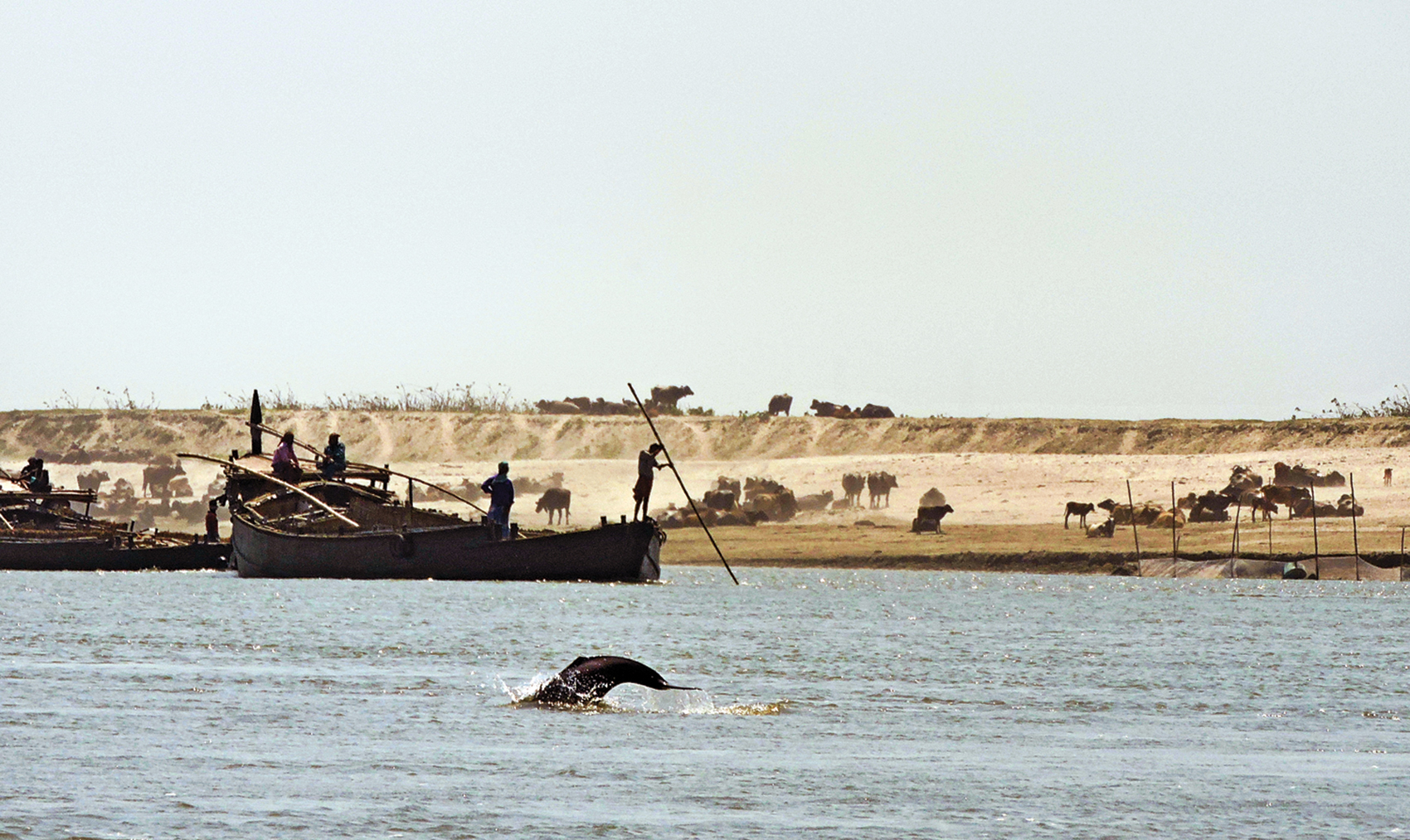
A Ganges river dolphin jumps out near country boats in the Kosi river, Bihar. Ganges river dolphins share river space with multiple human uses in the Gangetic plains. Photo: Jagdish Krishnaswamy.
What happens in a typical scenario if a dolphin is caught in a fishing net?
The dolphin usually dies after getting entangled in a fishing gillnet. Most such nets are set overnight. Fishers may flow the carcass away or sink it underwater, so that they are not seen as “killing” an endangered species. Some fishers also use the flesh and oil from a dead dolphin as fishing bait. The extent of such “salvage use” is unknown but is likely to be significant in some areas of India and Bangladesh. In most cases, detection by forest authorities is rare, and so this illegal act continues. That said, it is always difficult to ascertain whether such bycatch is accidental or intended, making it difficult to prove criminal intent. We even found that most dolphin deaths happen in fishing nets that are “legal” as per fishery laws. In most cases, reactive measures come into play, like banning all nets in an area, irrespective of whether they can entangle a dolphin or not. This leads to conflict between local fishers and the Forest Department, ultimately short-changing conservation. To help build trust, mechanisms need to be in place for fishers to report bycatch and allowances need to be made for some accidental bycatch.
Do fishers incur losses, like damages to fishing gear, because of protected and endangered species?
Fishers’ nets get damaged by animals frequently. Many small gillnets, locally called current jaal or hawajaal, are made of thin nylon monofilaments, which animals such as otters can easily tear to steal fish. Damages to nets are common where riverine species are in good numbers. Losses can be to the tune of a few thousand rupees annually per fisher, which are quite substantial given their average earnings.
I saw a heartening picture of a fisherman carrying a dolphin like a child, on his shoulder. The dolphin was caught in his net, and he released it back into the river. To what extent does this reflect the ground reality? Considering the age-old cultural connections between fishers and aquatic predators, do you think they can become allies for conservation?
Fishers have been doing it all – sometimes releasing, sometimes capturing, and sometimes killing dolphins and other animals in the river. Among fishing groups as well, there is a great cultural diversity, with a range of historical connections. Some fishers do not harm most animals, others are culturally driven towards hunting some species for food, or the use of products from these animals (oil from dolphins, or meat from turtles). So, the extent to which fishers will actively engage in pro- or anti-conservation behaviour can vary from settlement to settlement, district to district, and state to state.
I firmly believe that irrespective of cultural inertias and preferences, fishers have been and can become allies for conservation. Outreach and awareness programmes are crucial. But the more important part is to look at the larger aspects of socio-economic development and livelihood security of fishers. Generally, what we see at present is that there are many incentives and programmes to “involve communities”, which are well-intended, but remain at the level of pretty pictures and posters. We must go deeper and engage more with fishers’ lives, so that there is organic trust-building. Conservation efforts must aim to go beyond celebratory events, platitudes, and monetary incentives. We need to create deliberative, equitable, and democratic spaces to help fishers convey the barriers they perceive in becoming allies to conservation.
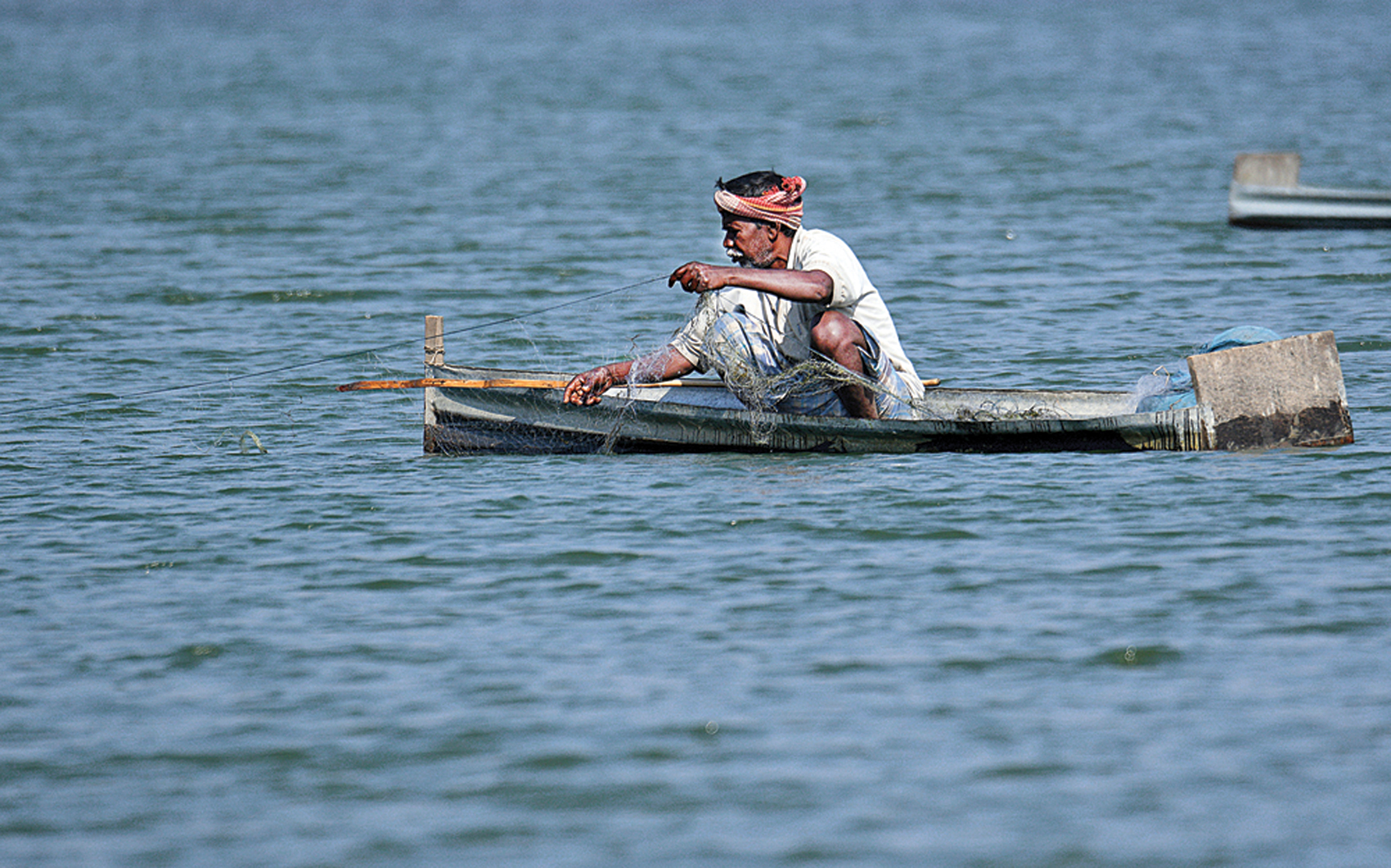
A fisherman pulling out his gill net after several hours of fishing in the Ganga river, West Bengal. Photo: Soumen Bakshi.
As head of the Wildlife Conservation Trust’s Riverine Ecosystems and Livelihoods (REAL) programme, which aspects of this complex issue are you focusing on, and where do you seek solutions?
Based on the existing body of work in these riverscapes, we consciously focus on both riverine ecosystems and livelihoods of fishers. Our project work integrates elements of fisheries management and conservation awareness with river biodiversity conservation planning, and is supported by the BNP Paribas India Foundation, DSP HMK Holdings Private Limited, and the Duleep Matthai Nature Conservation Trust. At present, our work is addressing an important gap by comparing issues related to managing capture fisheries inside and outside Protected Areas (PAs). We are broadly looking at how we can weave in capture fisheries management with wildlife conservation, and the legal, institutional, socio-economic, and ecological aspects of the same. Of course, factors such as law, fishing rights, or cultural practices are connected deeply with the histories of fisherfolk as well as the long-term ecological and hydro-climatic changes that they have experienced. The larger aim is to identify the policy gaps that need to be addressed to find a balance between sustainable fishing-based livelihoods and wildlife conservation. Our work on rivers of the Gangetic plains is quite interdisciplinary – it entails ecological surveys, hydrological and remote-sensing studies, socio-economic studies, and policy analyses, all at once. That is also what makes it very exciting.
I am fortunate to have a committed team. Subhasis Dey, who manages all field operations, has vast experience, having been closely involved with fishing communities in Bihar for over 20 years. Our assistants are youngsters from fishing communities, who keep us cognizant of the aspirations and self-image of the younger generation of fishers.
We also prioritise capacity building and training of frontline forest staff and other stakeholders involved in conservation outreach and awareness, in the basics of capture fisheries management. For them, all fishing is illegal, or bad, irrespective of the existing laws or the impact of different nets on wildlife. Fishing comprises a diverse bunch of activities, a portfolio, and not all fishing is detrimental to wildlife in freshwater ecosystems. We aim to communicate this knowledge, with scientific reasoning and evidence, to policy makers, to develop new regulations and an adaptive management system.
Are sustainable fisheries possible, especially in river systems that are the last refuge of endangered species? Or is it just a paper concept?
Yes, I do believe that sustainable fisheries are possible, even in river systems that are the last refuge of endangered species. But we need to define sustainability objectives carefully. Given that riverine capture fisheries provide basic subsistence to millions of rural poor, valuing them just in terms of total revenue or profit earned by the state will be unfair. If our target is cheap and affordable nutrition for people, and sustainable livelihoods through subsistence and small-scale fishing, we will need some unconventional thinking. One notion regarding species- or size-selective harvesting of mature fish is now being challenged by biologists. They are showing, with compelling evidence, that having fishing intensity proportional to the natural abundance of fish in different age-classes (juvenile, sub-adult, adult), called “balanced harvesting”, may actually sustain multi-species, multi-gear tropical fisheries. This would mean that immature fish are also harvested along with some mature fish, but in a controlled way. “Balanced harvesting” approaches could help sustainably harvest multiple species, change value chains, as well as improve trophic dynamics without overfishing. Balanced harvesting is no panacea, but I will submit that such new and biologically sound thinking must be considered and experimented with in new management approaches. Of course, this will mean a lot of structural and paradigmatic changes to existing fishery laws, which still carry significant historical and colonial baggage. This would also mean redefining what we typically bracket as “illegal” and “legal” fishing practices based on over-simplistic criteria. It would also mean creating cooperative and locally rooted institutions to govern and regulate fisheries. It would mean adaptive management and monitoring to allow for sustainable, welfare-oriented, small-scale fisheries to continue even in areas with good densities of endangered riverine wildlife.
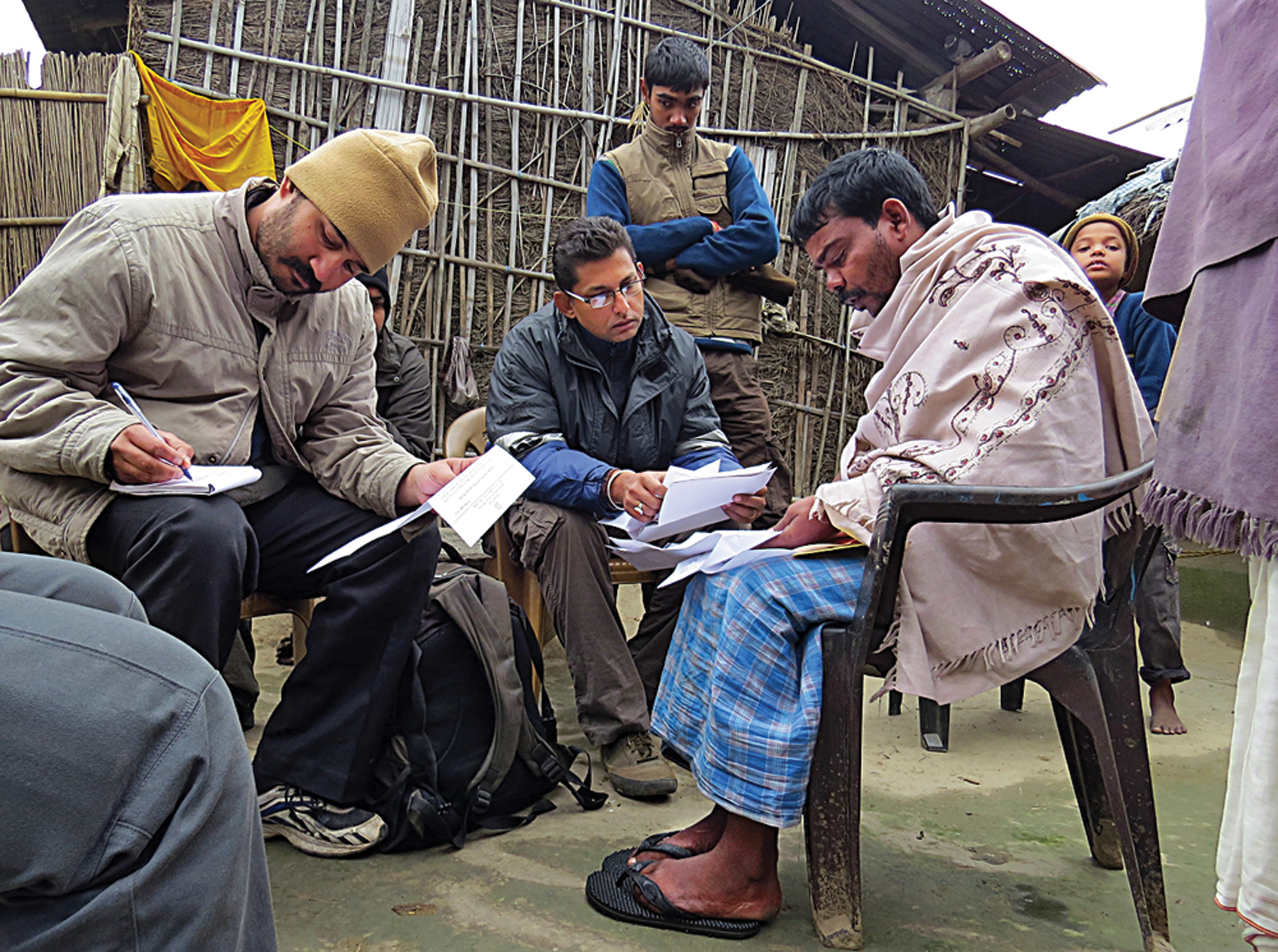
Nachiket Kelkar (left) and Subhasis Dey (centre) of WCT’s REAL programme interview a fisherman in the Kosi region of Bihar. Interactions with fishers over many years have helped them track the changes witnessed by fisherfolk in the rivers they depend on, and in their own lives, families and communities. Photo: Tarun Nair
Which laws come into play in freshwater ecosystems within PA boundaries and outside of them? Is there coherence or confusion?
The Indian Wild Life (Protection) Act, 1972, prohibits any hunting or killing of endangered species irrespective of PA boundaries. Fishery laws are state-level laws. But defining fishing rights is more of a policy issue. So, fishing rights may be defined or delimited in different water bodies differently at different times. This is a complex issue, where traditional use and informal access rights of fishers exist, but may not always find legal or institutional recognition. For livelihood security, it is important to respect, acknowledge, and work with local customary and informal arrangements of fishers with other users of water bodies. Fishing, trapping, etc. is prohibited within PAs, but some exceptions are made for fishers residing near PAs, mainly with marine PAs in mind. No similar clause exists for riverine PAs. The new challenge is to work out what ways of fishing can be included with “forest rights” under the provisions of the Forest Rights Act. In some areas, fishing rights are granted to forest-dwelling communities. In PAs deemed critical for freshwater species, there is great unease – sometimes rightly so – in granting fishing rights along with the bundle of forest rights.
What is your vision in terms of law and policy amendments that would make riverine capture fisheries more sustainable, secure fisher livelihoods, as well as help protect threatened species?
First and foremost, the policy neglect of riverine capture fisheries has to stop. This must begin with creating and fostering community-level institutions to manage riverine capture fisheries. Riverine fisheries are a ‘commons’, and there is a need to develop communication and cooperation systems between fishing groups living by the riverside, so that they are able to sustain fishing in their area better, without conflicts with each other. There is a large cooperative institutional setup in our country that can enable this, but it seems to have kind of “given up” on the matter of capture fisheries. At present, they are happy just stocking ponds with all sorts of fish and granting leases at random. Second, there should be better spatial planning and regulations, specific to the kinds of fishing practices used. The objective of capture fisheries must be livelihood security and not revenues to the state. The state’s engagement has to change from a profit-driven regime to a welfare-driven one. Goals for sustainability do not have to be set in stone, but should be flexible enough to evolve with time.
The views expressed by the interviewee are personal.






